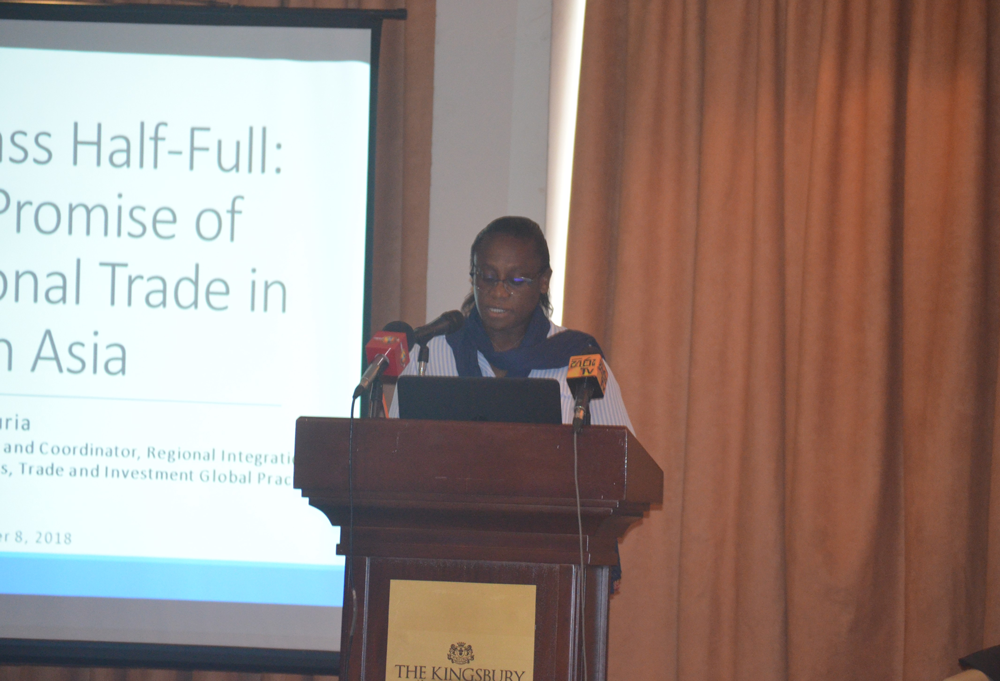WORLD BANK
Global launch of regional trade report titled “A Glass Half Full: The Promise of Regional Trade in South Asia” Speech by Dr. Idah Pswarayi-Riddihough, Country Director for Sri Lanka and the Maldives
Hon. Mallik Samarawickrama, Minister of Development Strategies and International Trade, Dr. Indrajith Coomaraswamy, Governor of the Central Bank of Sri Lanka, distinguished guests, colleagues, ladies and gentlemen. Good Morning!
I am very happy to have this opportunity to welcome you all to the discussion of this important report, A Glass Half Full: The Promise of Regional Trade in South Asia. Trade has again become a global topic. No longer is it a topic any one country can ignore, and if they do so, they ignore to their own peril.
It has become evident that all economies need to trade. Some do it better than others. Economies are inter-dependent and the benefits of embracing this phenomenon – in a smart manner – outweighs the benefits of going it alone.
Today’s session will unpack the challenges regional trade faces in South Asia. In doing so it will shed light on how the eight countries that comprise the world’s most rapidly growing region can fully benefit from the proximity they enjoy with each other. Globally, trade has played a critical role in reducing poverty. But South Asia, which accounts for a third of the world’s poor, remains the world’s least integrated region. The result is much reduced benefits than could be enjoyed by the respective economies, and subsequently by its citizens. One can no longer afford to fear cross-border trade; rather that energy will be better spent ensuring that when borders open the companies and products that become exposed to this new competition can remain competitive.
So far, much of the analysis of trade in South Asia has addressed the obstacles to trade from a higher-level perspective and provided policy suggestions at a similar level of aggregation. However, such broad guidance does not seem to have catalyzed any significant momentum in South Asia toward removing critical policy obstacles.
In the report we are discussing today, the World Bank Group has carried out four specific, in-depth studies that reflect major obstacles to trade; with the objective of providing actionable recommendations that are useful for policy makers. Given a plethora of analyses available on this subject, the report goes beyond the ‘what’ to ‘how” can trade liberalization can be done, maximizing the positive impact and taking care of the negative impacts, on participating economies.
Literature shows that in East Asia, most of the countries have benefited from a more open approach to trade, with a resulting increase in sustained growth and poverty reduction. A particularly interesting example is Vietnam. Vietnam’s trade to GDP ratio is 190 percent, versus 37 percent for Sri Lanka, despite the former being a much larger country. Vietnam’s FDI inflows are 6.3 percent of GDP, versus 1.6 percent for Sri Lanka. Overall, Vietnam’s growth has been 6.5 percent since 2000.
Sri Lanka has started to take some much-needed measures to open its economy in recent years. In the 2017 budget, it rationalized para-tariffs for about 1200 tariff lines, which was a significant step to cleaning up the complex and non-transparent tariff regime. On trade and investment facilitation, the trade information portal was launched in July, and has seen good uptake by traders since that launch. All major technical work for preparing the blueprint for a National Single Window is complete. Similarly, the Board of Investment of Sri Lanka has signed a Memorandum of Understanding to set up a Single Window Investment Facilitation Taskforce (SWIFT).
The report also brings in the much-neglected factor of trust. Without trust it’s hard to do business.
So, why should Sri Lankans care about regional trade and connectivity? Because there are benefits to be had from access to a greater variety of goods and services at cheaper prices. The business community will gain improved access to a large and dynamic South Asian market, and to inputs and technology.
I hope this report helps underpin a better understanding of regional trade issues and provides a platform and strong evidence base around which these can be discussed. It is my hope that it also helps to build a roadmap to more integration between the South Asian neighbors.
I wish you all a fruitful and engaging discussion.
Thank You!





